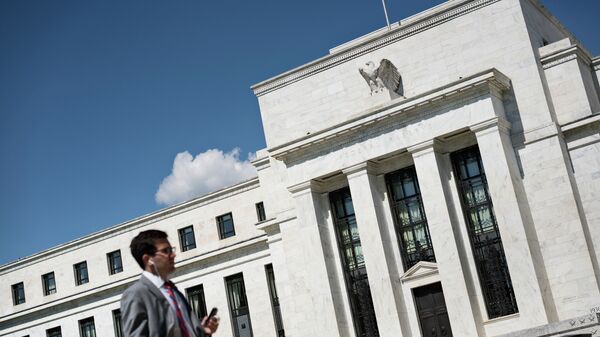Kristian Rouz — The US Department of Commerce released on Tuesday a revised report on the nation's Q3 GDP growth. The US economy expanded at a faster pace than estimated previously as it turned out businesses have accumulated greater commodity reserves than accounted for during the initial calculations.
US commodity stockpiles rose by $90.2 bln during the third quarter year-on-year, about twice as much as previously estimated. However, this is still a slowdown compared to the robust Q2, when inventories added $113.5 bln. Quarterly growth dropped by 0.6% compared to previous estimated of a 1.4% decline.
The excessive accumulation of commodities in the US is a consequence of the dollar's strength and the disruption of international trade ties amidst the wave of collapses and devaluations across the globe. Commodities are cheap for US manufacturers, but US manufactured goods are too expensive to export, meaning a massive amount of commodity and manufactured goods are piling up in US warehouses.
"This is a sturdy second GDP print for the third quarter when looking past the inventory swings," Robert Kavcic of the Toronto-based BMO Capital Markets said. "Importantly, domestic demand in the US economy remains very solid, something that will surely give comfort to the Fed as it ponders its next move."
That same report by the Commerce department also said the corporate earnings had been brutally slashed by the dollar's strength, while effective incomes soared amidst a slight rise in wages and persistently low inflation. Corporate pretax earnings declined 1.1% in Q3 after having risen 3.5% in the second quarter. The dollar's strength has wiped out some $30 bln overseas earnings off the US enterprises' balance sheet in the third quarter. After-tax corporate earnings suffered an even worse slump, down 4.7% year-on-year, the biggest decline since mid-2009.
Salaries and wages rose by $102.7 bln in Q3, some $62 bln higher than previously estimated, after a $109.4 bln advance in the robust second quarter. Inflation-adjusted after-tax personal disposable incomes rose 3.8% in Q3 year-on-year, the greatest gain since late 2012.
Consumer spending, remaining the key driver to the US economy, was slightly downgraded for the third quarter a tad, although remained solid. Household consumption accounts for 72% of the US GDP, and it expanded 3% in the third quarter compared to the previous estimate of 3.2% growth.
Meanwhile, there is some anxiety in the US mining sector. US energy companies are cutting capital investment amidst the persistent oil bust, and cheap crude is holding down the GDP expansion even though cheap petrol renders US households' incomes higher. Capital spending on mining exploration and drilling dropped 47.1% in Q3 compared to the previous estimate of 46.9%.
Construction in also under pressure. Investment in commercial property development dropped an annualized 7.1% in Q3 compared to the initially estimated decline of 4.0%.
While the US unemployment is within the ‘full employment‘ gauge at some 5% out of work, inflation is bound to accelerate. Nonetheless, the current challenges in the corporate sector and energy, along with global concerns, might prevent the US Federal Reserve from raising borrowing costs during their policy meeting on 15-16 December.




